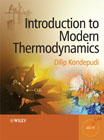
The first modern approach to thermodynamics written specifically for a first undergraduate course, Introduction to Modern Thermodynamics covers the fundamental formalism with some attention given to its history; describes basic applications of the formalism; and contains a number of additional applications that instructors can use according to their particular degree. A wide range of examples appear throughout the book from biological, engineering, and atmospheric systems. INDICE: Preface 1 BASIC CONCEPTS AND THE LAWS OF GASES Introduction 1.1 Thermodynamic Systems 1.2 Equilibrium and Nonequilibrium Systems 1.3 Biological and Other Open Systems 1.4 Temperature, Heat and Quantitative Laws of Gases 1.5 States of Matter and the van der Waals Equation 1.6 An Introduction to Kinetic Theory of Gases Appendix 1.1: Partial Derivatives Appendix 1.2: Elementary Concepts in Probability Theory Appendix 1.3: Mathematica Codes References Examples Exercises 2 THE FIRST LAW OF THERMODYNAMICS The Idea of Energy Conservation amidst New Discoveries 2.1 The Nature of Heat 2.2 The First Law of Thermodynamics: The Conservation of Energy 2.3 Elementary Applications of the First Law 2.4 Thermochemistry: Conservation of Energy in Chemical Reactions 2.5 Extentof Reaction: A State Variable for Chemical Systems 2.6 Conservation of Energyin Nuclear Reactions and Some General Remarks 2.7 Energy Flows and Organized States Appendix 2.1: Mathematica Codes References Examples Exercises 3 THE SECOND LAW OF THERMODYNAMICS AND THE ARROW OF TIME 3.1 The Birth of the Second Law 3.2 The Absolute Scale of Temperature 3.3 The Second Law and the Concept of Entropy 3.4 Entropy, Reversible and Irreversible Processes 3.5 Examples of Entropy Changes due to Irreversible Processes 3.6 Entropy Changes Associated withPhase Transformations 3.7 Entropy of an Ideal Gas 3.8 Remarks about the Second Law and Irreversible Processes Appendix 3.1: The Hurricane as a Heat Engine Appendix 3.2: Entropy Production in Continuous Systems References Examples Exercises 4 ENTROPY IN THE REALM OF CHEMICAL REACTIONS 4.1 Chemical Potential andAffinity: The Thermodynamic Force for Chemical Reactions 4.2 General Properties of Affinity 4.3 Entropy Production Due to Diffusion 4.4 General Properties of Entropy Appendix 4.1: Thermodynamics Description of Diffusion References Examples Exercises 5 EXTREMUM PRINCIPLES AND GENERAL THERMODYNAMIC RELATIONS Extremum Principles in Nature 5.1 Extremum Principles Associated with the Second Law 5.2 General Thermodynamic Relations 5.3 Gibbs Energy of Formation and Chemical Potential 5.4 Maxwell Relations 5.5 Extensivity with Respect to N and Partial Molar Quantities 5.6 Surface Tension References Examples Exercises 6 BASIC THERMODYNAMICS OF GASES, LIQUIDS AND SOLIDS Introduction 6.1 Thermodynamics of Ideal Gases 6.2 Thermodynamics of Real Gases 6.3 Thermodynamics Quantities for Pure Liquids and Solids Appendix 6.1 Equations of State References Examples Exercises 7 THERMODYNAMICS OF PHASE CHANGE Introduction 7.1 Phase Equilibrium and Phase Diagrams 7.2 The Gibbs Phase Rule and Duhems Theorem 7.3 Binary and Ternary Systems 7.4 Maxwell's Construction and the Lever Rule 7.5 Phase Transitions References Examples Exercises 8 THERMODYNAMICS OF SOLUTIONS 8.1 Ideal and Nonideal Solutions 8.2 Colligative Properties 8.3 Solubility Equilibrium 8.4 Thermodynamic Mixing and Excess Functions 8.5 Azeotropy References ExamplesExercises 9 THERMODYNAMICS OF CHEMICAL TRANSFORMATIONS 9.1 Transformations ofMatter 9.2 Chemical Reaction Rates 9.3 Chemical Equilibrium and the Law of Mass Action 9.4 The Principle of Detailed Balance 9.5 Entropy Production due to Chemical Reactions 9.6 Elementary Theory of Chemical Reaction Rates 9.7 Coupled Reactions and Flow Reactors Appendix 9.1: Mathematica Codes References Examples Exercises 10 FIELDS AND INTERNAL DEGREES OF FREEDOM The Many Faces of Chemical Potential 10.1 Chemical Potential in a Field 10.2 Membranes and Electrochemical Cells 10.3 Isothermal Diffusion References Examples Exercises 11 INTRODUCTION TO NONEQUILIBRIUM SYSTEMS Introduction 11.1 Local Equilibrium 11.2 Local Entropy Production, Thermodynamic Forces and Flows 11.3 Linear Phenomenological Laws and Onsager Reciprocal Relations 11.4 Symmetry-Breaking Transition and Dissipative Structures 11.5 Chemical Oscillations Appendix 11.1: MathematicaCodes References Further Reading Exercises 12 THERMODYNAMICS OF RADIATION Introduction 12.1 Energy Density and Intensity of Thermal Radiation 12.2 The Equation of State 12.3 Entropy and Adiabatic Processes 12.4 Wiens Theorem 12.5 Chemical Potential of Thermal Radiation 12.6 MatterAntimatter in Equilibrium withThermal Radiation: The State of Zero Chemical Potential References Examples Exercises 13 BIOLOGICAL SYSTEMS 13.1 The Nonequilibrium Nature of Life 13.2 Gibbs Energy Change in Chemical Transformations 13.3 Gibbs Energy Flow in Biological Systems 13.4 Biochemical Kinetics References Further Reading Examples Exercises 14 THERMODYNAMICS OF SMALL SYSTEMS Introduction 14.1 Chemical Potential of Small Systems 14.2 Size-Dependent Properties 14.3 Nucleation 14.4 Fluctuations and Stability References Examples Exercises 15 CLASSICAL STABILITY THEORY 15.1 Stability of Equilibrium States 15.2 Thermal Stability 15.3 Stability with Respect to Fluctuations in N References Exercises 16 CRITICAL PHENOMENA AND CONFIGURATIONAL HEAT CAPACITY Introduction 16.1 Stability and Critical Phenomena 16.2 Stability and Critical Phenomena in Binary Solutions 16.3 Configurational Heat Capacity Further Reading Exercises 17 ELEMENTS OF STATISTICAL THERMODYNAMICS Introduction 17.1 Fundamentals and Overview 17.2 Partition Function Factorization 17.3 The Boltzmann Probability Distribution and Average Values 17.4 Microstates, Entropy and the Canonical Ensemble 17.5 Canonical Partition Function and Thermodynamic Quantities 17.6 Calculating Partition Functions 17.7 Equilibrium Constants Appendix 17.1: Approximations and Integrals References Examples Exercises LIST OF VARIABLES STANDARD THERMODYNAMIC PROPERTIES PHYSICAL CONTANTS AND DATA INDEX
- ISBN: 978-0-470-01599-5
- Editorial: John Wiley & Sons
- Encuadernacion: Rústica
- Páginas: 552
- Fecha Publicación: 29/02/2008
- Nº Volúmenes: 1
- Idioma: Inglés
